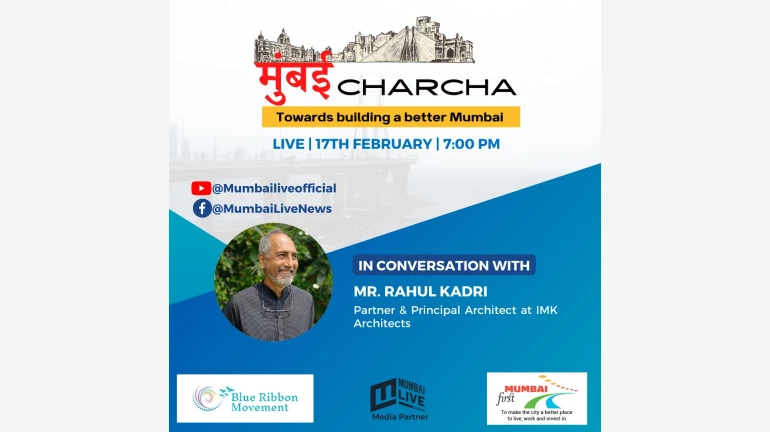
In this edition of Mumbai Charcha, Rahul Kadri an urban design expert shares his two cents about the infrastructure in Mumbai. Kadri has been a part of many iconic projects of Mumbai and has received global recognition for his immaculate developments.
Hailing from a family of architects, his residence at Nepeansea Road enabled him to forge a relationship with the sea. This coupled with the many conversations he had with his father about architecture and walking with his dog in nearly every part of Mumbai curated his outlook towards the domain.
While he is presently working on building an elevated path in the forest at Malabar Hill, Kadri remarked, “We are blessed to have many open spaces left to the city by the British, but the density of the city is increasing and open spaces haven’t kept up with growing numbers.”
He added that the FSI began changing mindsets in 1989 because everyone began valuing their property differently. He believes that not only has the square meters per person dropped but the absence of long-range planning has caused hindrances.
Further into the conversation, he threw light upon the fact that those in positions of power have been encouraging green activity. Kadri vocalised that the BMC has been working on streamlining spaces available to cars, doubling the area available to those who walk and cycle.
On being asked how more value can be added to Mumbai’s beauty, Kadri maintains that mechanisms need to be in place for people’s voices to be heard. Apart from prioritising, he also thinks the authority needs to go back to the Maharashtra Town Planning Act (1967) to bring back reforms since certain principles of planning don’t apply anymore.
Kadri then went on to share certain historical nuances about Mumbai and uttered, “Mumbai was a port town and to deal with pollution, planners decided to segregate industries in a specific location. While people lived in one place, offices were elsewhere for hygiene reasons which led to the need for transportation facilities.”
“Now, however, we need to upgrade principles of planning, this includes reforms in the planning process which needs continuous improvement through neighbourhood planning. Through this, people in the neighbourhood tell the administration what they want.” Kadri elaborated, “Civic authorities should call citizens and ask what they want. This should be rated to understand the priorities of the community.”
Sharing a bigger perspective, on how Mumbai can grow in leaps and bounds, he declared that there are 2,000 cities in the world where 30 per cent of the capital budget are decided by citizens. These include the likes of New York and even Pune which has been doing it for the past decade.
Apart from utilizing a similar mechanism, he questions why land use planning is being undertaken in such a way where there are different zones and asks why there can’t be mixed-use. He juxtaposes his opinion by saying that areas such as Pydhonie and Bhuleshwar are built in such a way where people work and live in the same vicinity.
Kadri claims that Brihanmumbai Municipal Corporation (BMC) data depicts that 50 per cent of the people walk to work while 25 per cent take the train and 15 per cent take the bus. He then goes on to appreciate the metro lines that have helped connect the east and west side of the city, he supposes that the Metro 3 will be a success because its underground nature will enable it to traverse through a dense locality without problems.
Kadri, however, has certain visions for the city too. These include the reduction in dependence on vehicles with people opting for public transportation, widening of pavements, redesigning of roads, underground transportation, utilization of roads as parks and treating roads as open spaces donned with local trees.
Kadri tells Mumbaikars that they have many opportunities in hand. From ample gardens on the west coast to partaking in public projects by discussions will future proof Mumbai’s development.
Similarly, on the governmental front, the way forward according to him is by lowering the density, with Maharashtra needing to plan its development. He comments, “Right now there are 22,000 people per square feet in Mumbai, thus, the government needs to disinvest in Mumbai and invest in 10 other cities so people spread out.
Commenting on Mumbai’s mega-project the Coastal Road he pronounces that the centre's decision that if any city thinks it needs a coastal road it can build it without needing permission is a violation that affects the fishing industry. He presumes this can be addressed by making an intertidal space model that will act as a benchmark for the rest of the world.
Amid the approaching BMC elections, he asks citizens to nudge corporators to be more democratic. Other than this, he hopes for a participatory budgetary process and a change in the BMC Act wherein it is required by law for them to take citizens into cognizance while making decisions.
Mumbai Charcha's next session will be conducted on February 24 with Dhaval Parab aka D'evil Hiphop artist, rapper and songwriter with Gully gang records.
Also Read: "Mumbai Is A Feeling Of Relaxed Belonging," Says Rajni Bakshi





